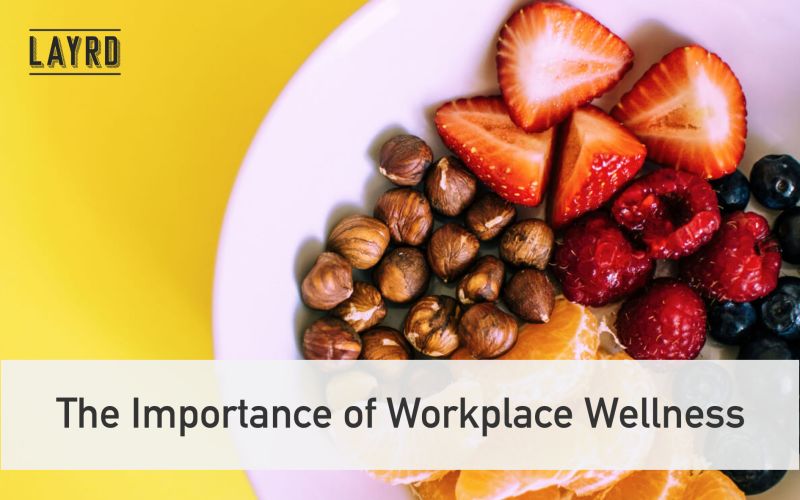
The Importance of Workplace Wellness
Laryd Design

In this article, we explore the concept of workplace wellness, the benefits for business and some of the practical steps you can take to support your team’s wellbeing.
Before we delve into why workplace wellness is important, we should start by explaining what it is. A good place to start is the International Labour Organization definition. It says:
“Workplace Wellbeing relates to all aspects of working life, from the quality and safety of the physical environment, to how workers feel about their work, their working environment, the climate at work and work organization.”
Put simply, ‘workplace wellness’ refers to the impact that a place of work has on individuals’ mental and physical health.
In recent years you may have noticed growing interest in the topic from both businesses and their employees. Why? Because there are big benefits for both parties. In fact, according to the Health & Safety Executive (HSE), 28.2m working days were lost in 2018/19 due to work-related illness; 12.8m of these were due to stress, depression and anxiety. That’s a lot of lost time for a business of any size.
Workplace wellness has also been linked to increased productivity, employee loyalty and retention rates. And given that it costs an average of £3,000 to hire someone in the UK, it’s clearly in a business’s interests to support their employees’ wellbeing.
And the benefits of workplace wellness for employees is clear too: individuals are healthier, happier and more inclined to enjoy their jobs.
So if you’re convinced of the benefits, what are the key steps you can take to improve wellbeing in your workplace?
Health initiatives


Encourage your employees to engage in healthy activities. From on-site yoga and fitness sessions, to giving away free fruit and healthy snacks, businesses can support healthy behaviours.
In fact, the benefits of exercise go beyond the physical. The endorphins and hormones released during exercise can help with mental health. Plus, team activities help employees to bond and feel like they belong.
And while open-plan offices get a bad rep, there are actually health benefits. Recent research published in the British Medical Journal shows that employees in open-plan offices are 31.8% more active than those in cubicles and private offices.
Ergonomic Environments
While it should come as no surprise, it’s worth a mention: furniture has a big impact on health and wellbeing.
The HSE states that 2.8m working days were lost due to back disorders in 2018/19. This could be eased or avoided by providing the right equipment, such as desks and workstations set at the correct height.
If your employees work remotely, consider investing in equipment for home working, reducing their risk of injury.
Biophilic Design


Biophilic design is a big trend right now, and for good reason. Biophilic design incorporates elements of the natural world into interior spaces to promote wellbeing.
From increasing the number of natural surfaces to promoting natural light and airflow, there are multiple different aspects to the trend. Want to incorporate biophilic elements in your workplace? Research shows that the presence of plants in a building can increase feelings of wellbeing by as much as 40%.
Flexible & Agile Working
While similar, these two practices are slightly different. Flexible working allows employees to shift their working hours and places of work to fit in with their lives, while agile working is more focused on the most efficient means of completing a task, which may include flexible working.
Either way, it can have significant benefits for individuals and businesses. Multiple studies demonstrate that increases job satisfaction and results in greater productivity.
Coronavirus Considerations
Of course, it would be remiss of us to not mention the ongoing coronavirus pandemic.
The virus has prompted businesses around the world to focus on workplace wellbeing like never before. Employers have made widespread changes to working practices to ensure the health and safety of their teams.
As a result, even the most traditional of businesses have introduced flexible and remote working. Office layouts have changed to introduce social distancing measures, while outdoor meetings have resulted in increased exposure to nature.
And it’s not likely to stop there. The impact of the pandemic will continue to affect our understanding of workplace wellbeing long into the future. We, like you, will have our eyes focused on the new trends as they develop.
Find out more
At Layrd Design, we’re committed to workplace wellness. Founder William Mayes is training to become a qualified WELL practitioner, formalising his skills and experience in this area, creating healthy, productive workplaces that encourage employees and businesses to thrive. If you’d like to promote workplace wellbeing in your business, get in touch.
Disclaimer:
Thank you for visiting our bog! This blog is a resource guide for inspirational and informational purposes. All the information found on my blog should be used at your own risk. All photos that are not taken by Layrd Design are linked to their sources and are widely available to download on the internet by the general public.
All the written content is copyrighted, copying of our written texts are prohibited.
You can view this original article here